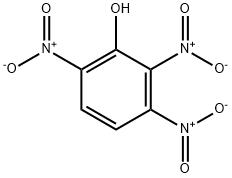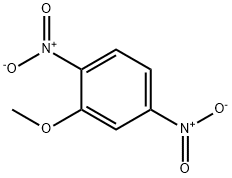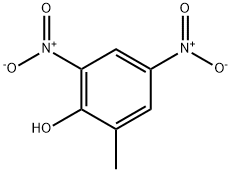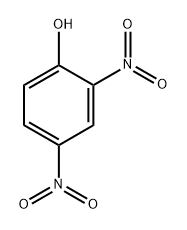2,5-DINITROPHENOL
Synonym(s):γ-Dinitrophenol
- CAS NO.:329-71-5
- Empirical Formula: C6H4N2O5
- Molecular Weight: 184.11
- MDL number: MFCD00007108
- EINECS: 206-348-1
- SAFETY DATA SHEET (SDS)
- Update Date: 2024-12-18 14:08:57

What is 2,5-DINITROPHENOL?
Chemical properties
Yellow needles, flammable. Soluble in ether, benzene, hot water, and ethanol.
The Uses of 2,5-DINITROPHENOL
2,5-Dinitrophenol (wetted with ca. 20% Water) (unit weight on dry weight basis) is a useful reagent for the preparation of yttrium nitrophenolate aminebis(benzotriazolylphenolate) complexes.
Definition
ChEBI: 2,5-dinitrophenol is a dinitrophenol having the nitro groups at the 2- and 5-positions.
General Description
Yellow crystalline solid with a sweet musty odor. Sinks and mixes slowly with water.
Air & Water Reactions
Slowly mixes with water.
Reactivity Profile
2,5-DINITROPHENOL can detonate or explode when heated under confinement [USCG, 1999]. Phenols do not behave as organic alcohols, as one might guess from the presence of a hydroxyl (-OH) group in their structure. Instead, they react as weak organic acids. Phenols and cresols are much weaker as acids than common carboxylic acids (phenol has Ka = 1.3 x 10^[-10]). These materials are incompatible with strong reducing substances such as hydrides, nitrides, alkali metals, and sulfides. Flammable gas (H2) is often generated, and the heat of the reaction may ignite the gas. Heat is also generated by the acid-base reaction between phenols and bases.
Health Hazard
INHALATION, INGESTION OR SKIN ABSORPTION: Fatigue, thirst, sweating, flushing of face, nausea, vomiting, abdominal pain, diarrhea; restlessness, anxiety, excitement occasionaly leading to convulsions; fever, tachycardia, labored respiration, cyanosis, and sometimes muscle cramps. Loss of consciousness, cessation of breathing and death. EYES: Causes dilation of pupils or posterior subcapsular opacities or cataracts. SKIN: Discoloration, irritation, and dermatitis.
Purification Methods
Crystallise 2,5-dinitrophenol from H2O with a little EtOH. [Beilstein 6 IV 1383.]
Properties of 2,5-DINITROPHENOL
| Melting point: | 103-106 °C(lit.) |
| Boiling point: | 318.03°C (rough estimate) |
| Density | 1.7195 (rough estimate) |
| refractive index | 1.4738 (estimate) |
| solubility | Solubility Sparingly soluble in water; soluble in ethanol, ether |
| pka | 5.21, 5.1, 5.0(at 25℃) |
| form | Solid |
| color | Yellowish needles |
| PH Range | 4(colourless)-5.8(yellow) |
| Merck | 14,3281 |
| BRN | 1913411 |
| Stability: | Light Sensitive |
| Major Application | Liquid crystal films, electrophotographic materials, adhesives, inks, lubricants, preservation of cut flowers, food storage, materials for evaluating dental cariesactivity |
| CAS DataBase Reference | 329-71-5(CAS DataBase Reference) |
| EPA Substance Registry System | 2,5-Dinitrophenol (329-71-5) |
Safety information for 2,5-DINITROPHENOL
| Signal word | Danger |
| Pictogram(s) |
 Flame Flammables GHS02  Skull and Crossbones Acute Toxicity GHS06  Health Hazard GHS08  Environment GHS09 |
| GHS Hazard Statements |
H228:Flammable solids H301:Acute toxicity,oral H311:Acute toxicity,dermal H331:Acute toxicity,inhalation H373:Specific target organ toxicity, repeated exposure H411:Hazardous to the aquatic environment, long-term hazard |
| Precautionary Statement Codes |
P210:Keep away from heat/sparks/open flames/hot surfaces. — No smoking. P240:Ground/bond container and receiving equipment. P241:Use explosion-proof electrical/ventilating/lighting/…/equipment. P260:Do not breathe dust/fume/gas/mist/vapours/spray. P261:Avoid breathing dust/fume/gas/mist/vapours/spray. P262:Do not get in eyes, on skin, or on clothing. P264:Wash hands thoroughly after handling. P264:Wash skin thouroughly after handling. P270:Do not eat, drink or smoke when using this product. P271:Use only outdoors or in a well-ventilated area. P273:Avoid release to the environment. P280:Wear protective gloves/protective clothing/eye protection/face protection. P284:Wear respiratory protection. P311:Call a POISON CENTER or doctor/physician. P391:Collect spillage. Hazardous to the aquatic environment P301+P310:IF SWALLOWED: Immediately call a POISON CENTER or doctor/physician. P405:Store locked up. P403+P233:Store in a well-ventilated place. Keep container tightly closed. P501:Dispose of contents/container to..… |
Computed Descriptors for 2,5-DINITROPHENOL
New Products
Indole Methyl Resin tert-butyl 9-methoxy-3-azaspiro[5.5]undecane-3-carboxylate Boc-His(Boc)-OH 2-CTC Resin 4-Chloro-7-tosy1-7Hpyrrolo[2,3-d]pyrimidine 5,7-Dibromo-1H-indole 2,5-dichloro-N-hydroxy-4,6-dimethylpyridine-3-carboximidamide 2,2-Dimethoxy-7-azaspiro[3.5]nonane hydrochloride 4-chloromethyl-5-methyl-1,3-dioxol-2-one (DMDO-Cl) R-2-BENZYLOXY PROPIONIC ACID 1,1’-CARBONYLDIIMIDAZOLE 1,1’-CARBONYLDI (1,2-4 TRIAZOLE) N-METHYL INDAZOLE-3-CARBOXYLIC ACID 4-((2-hydroxyethyl)thio)benzoic acid 1-(TERT-BUTOXYCARBONYL)-2-PYRROLIDINONE Methyl 6-methylnicotinate 3-Pyridineacrylic acid tert-Butyl carbazate TETRAHYDRO-2H-PYRAN-3-OL 2-((4-morpholinophenylamino) (methylthio) methylene) malononitrile 3-(4-morpholinophenylamino)-5-amino-1H-pyrazole-4-carbonitrile 2,4-dihydroxybenzaldehyde 1,3-Diethyl-1,3-Diphenylurea Methyl 2-methylquinoline-6-carboxylateRelated products of tetrahydrofuran








You may like
-
 Pyridine 99.5% HPLC /UV SpectroscopyView Details
Pyridine 99.5% HPLC /UV SpectroscopyView Details
110-86-1 -
 Guanine , 99%View Details
Guanine , 99%View Details
73-40-5 -
 Piperazine Spot supply, best priceView Details
Piperazine Spot supply, best priceView Details
110-85-0 -
 Potassium Hydroxide 90%View Details
Potassium Hydroxide 90%View Details
1310-58-3 -
 Dibutyl PhthalateView Details
Dibutyl PhthalateView Details
84-74-2 -
 Imidazole Spot supply, competitive priceView Details
Imidazole Spot supply, competitive priceView Details
288-32-4 -
 Octadecyl 3-(3,5-di-tert-butyl-4-hydroxyphenyl)propionate 98% (GC)View Details
Octadecyl 3-(3,5-di-tert-butyl-4-hydroxyphenyl)propionate 98% (GC)View Details
2082-79-3 -
 Thiourea 99% ARView Details
Thiourea 99% ARView Details
62-56-6
